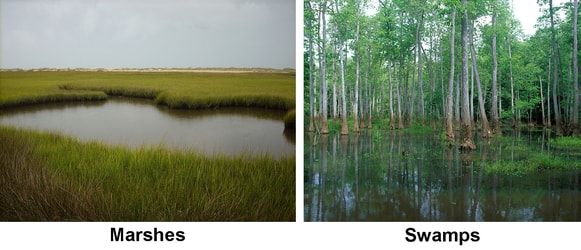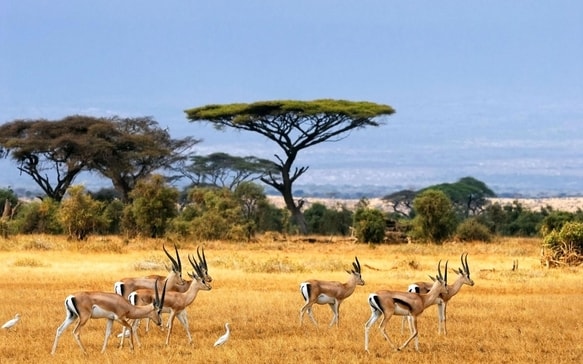Back to: BIOLOGY SS2
Welcome to Class !!
We are eager to have you join us !!
In today’s Biology class, We will be learning about Terrestrial Habitat. We hope you enjoy the class!

CONTENT
- Terrestrial Habitats
- Marsh
- Forest
- Grassland
- Arid land
TERRESTRIAL HABITATS
Organisms of the land are called terrestrial organisms. They include plants and animals that are found living on the ground and under the ground.
Basically, terrestrial habitat is subdivided into four main parts, namely;
- marsh
- forest
- grassland/ savanna
- arid land/ desert
EVALUATION
- What are terrestrial organisms?
- List four types of terrestrial habitats
MARSH
A Marsh is low land, flooded in rainy season and usually waterlogged because of poor drainage. The vegetation is predominantly of grasses and shrubs. When trees grow in a marsh, it is called a swamp. Marsh is a transition between the aquatic habitat and terrestrial habitat.

FORMATION OF A MARSH
Marshes develop as a result of water overflowing its banks to accumulate on the adjoining coastal or low land area such as flood plains of rivers. This can be enhanced with extensive rainfall.
When ponds and lakes are filled up with soil and organic debris of plants, marshes can also be formed. Marshes formation is, therefore, a gradual process. Marshes can either be freshwater or saltwater marshes.
CHARACTERISTICS OF A MARSH
- A marsh is a lowland.
- It is always flooded, wet and waterlogged.
- It sometimes has a pool of standing water.
- It has a high relative humidity
- Its water sometimes contain many decaying organisms
- The water has a foul smell
ORGANISMS OF THE MARSH
There are various plants and animals in this habitat. The plants include algae, grasses, water lettuce, water lilies, white and red mangrove, raphia palms e.t.c.
Animals found in the marsh include mangrove crabs, lagoon crabs, hermit crabs, mud-skippers, fishes, frogs, snakes, crocodiles, mammal e.t.c.
Adaptive features of organisms of the marsh include
- They must be able to tolerate the salinity of the soil or water
- They have to tolerate low oxygen concentration in the soil or water
Plants of freshwater marsh have other adaptive features similar to those of freshwater habitat. Likewise the plants of saltwater marsh.
Saprophytic organisms (e.g. bacteria) which live on dead organic matter in marshes have to adapt to the anaerobic condition.
FOOD CHAINS IN MARSHES
- Flowering plants → insects → frogs → crocodiles
- Humus → earthworms → frogs → snakes
EVALUATION
- How is a marsh formed
- State four characteristics of a marsh
- List four plants and animals found in the marsh
FORESTS
A forest is a community of plants in which trees species are dominant. There are different kinds of forests whose distribution is determined mainly by climatic factors such as temperature, rainfall and at times by soil elevation and man’s activities such as farming, lumbering, bush burning, construction of roads and building.
The major type of forest in Nigeria is the rain forest

CHARACTERISTICS OF A FOREST
- The forest is rich in epiphytes and climbers
- The interior of the forest has high humidity, low light intensity and damp floor.
- Presence of tall trees with canopies and existing in layers (stratified).
- Trees are mesophytes with broad leaves.
- The trees have buttress roots to support their heavyweight and height.
- The trees have thin barks for gaseous exchange and transpiration.
PLANTS DISTRIBUTION AND ADAPTATION
Forest plants (trees) include African walnut, mahogany, teak, obeche, iroko, oil palm, ferns (pteridophytes), bryophytes (mosses and liverwort), epiphytes (orchid), fungi and mistletoe e.t.c. these plants adapt to life in the forest in the following ways;
- Possession of strong taproot systems and buttress roots.
- Possession of tall unbranched trunks
- Possession of broad leaves
- Epiphytes have a mechanism (the aerial roots) storing water and absorbing moisture from the air while growing on tree branches.
- Mistletoe (plant parasite) develops a root system that can penetrate the stem of a plant withdrawing manufactured food directly from phloem vessels of the host plant.
ANIMALS DISTRIBUTION AND ADAPTATION
Most forest animals are arboreal (living on trees) and these include bats, monkeys, snakes, squirrels, birds, tree frogs, chameleons. Some live in the soil e.g. earthworms and beetles while others live among the litters on the ground e.g. millipedes, ants, snails.
These animals adapt to the forest in the following ways
- Monkeys have prehensile tails and long limbs for climbing and jumping.
- Bats modify their limbs into wings for flight
- Green snakes have protective colouration to camouflage
- Chameleon has a prehensile tail and opposable digits for grasping as well as protective colouration to camouflage
- Apes move in groups for protection, with a high sense of sight
- Earthworms and snails have water permeable cuticle to reduce water loss and prevent desiccation.
- Birds have powerful wings for flight
FOOD CHAINS IN A FOREST
- Green plants → grasshoppers → toads →hawks
- Green plants → monkeys → lions
EVALUATION
- Describe a forest habitat using its characteristics
- Give two examples of a food chain in a forest
GRASSLAND [SAVANNA]
This is a plant community in which grass species are dominant, but trees and shrubs may be present.

CHARACTERISTICS OF GRASSLAND
- Temperature is usually high and sunshine is intense.
- The relative humidity is low and rainfall scanty (60 – 150cm annual rainfall).
- Abundant grassland with few short trees sparsely distributed
- Bush fire is frequent and trees are fire-resistant
- Deciduous plants (plants that shed their leaves in dry seasons) are present.
- Plants possess underground stems and deep roots to search out for water
- Trees have modified leaves for adaptation to the environment
TYPES OF SAVANNA
Basically, there are four major types of savanna in Nigeria, namely;
- Southern Guinea savanna
- Northern guinea savanna
- Sudan savanna
- Sahel savanna
Southern Guinea savanna is the largest biome in Nigeria
PLANTS DISTRIBUTION AND ADAPTATION IN GRASSLANDS
The grassland plants include acacia, elephant grass, guinea grass, spear grass, palms, baobab trees e.t.c. their adaptive features include
- Trees have thick corky barks to resist severe fire
- Grasses with underground stems to escape fire and drought
- Leaves with a waxy surface in addition to cuticle covering to reduce transpiration
- Reduced or small leaves to reduce transpiration
- Presence of curly leaves to conserve water
- Leaves fall (deciduous) in drying season to conserve water
- Baobab trees have broad and succulent leaves to conserve water
ANIMALS DISTRIBUTION AND ADAPTATION IN A FOREST
Animals found in the forest adapt to this habitat in the following ways
- Termites lived in air-conditioned nests called anthills for cooling the animals.
- Rats burrow into the soil to avoid excessive heat and fire
- Zebras and giraffes can camouflage using their colours.
- Lions, tigers and leopards have powerful claws and teeth for attacking animals.
- Kangaroos have long legs to help them escape from danger and also have a pocket of flesh to shield their young ones from hot weather and attack.
- Elephants and lion move in groups or herds to achieve strength in number
FOOD CHAINS IN GRASSLAND
There are several food chains due to numerous animals
- Grass → grasshoppers→ lizards → snakes
- Grass → grasshoppers → toads → birds
- Grass → zebras → lions
ARID LANDS [DESERTS]
These are areas of very low rainfall and high evaporation rate. They are the driest habitats, receiving less than 25cm annual rainfall. Arid lands are of two types;
- Hot deserts e.g. Sahara desert (North Africa), Kalahari desert (South Africa)
- Cold deserts e.g. desert in North America

CHARACTERISTICS OF A DESERT
- Water is very scarce
- Temperature is very high by the day and very low by the night
- Vegetation is very scanty
- The soils are sandy or rocky
- Strong winds occur frequently and sunshine very intense
- Presence of drought resistance plants (xerophytes)
PLANTS DISTRIBUTION AND ADAPTATION IN DESERTS
Deserts plants include thorny bushes, cacti, scattered dwarf acacia, date palm, wiring grasses, baobab trees and euphorbia species. They adapt to this habitat in the following ways;
- Plants have thin leaves to reduce transpiration
- Cacti leafless have thorns to reduce transpiration and thick succulent stem to store water
- Acacia (drought resistant) has deep roots which absorb underground water
- The baobab tree has waxy leaves which can be hairy or needle-shaped to reduce the rate of transpiration
- Wiring grass has narrow and slender leaves to reduce transpiration.
ANIMAL DISTRIBUTION AND ADAPTATION IN DESERTS
The deserts animals include camel, rodents, lizards, snakes, zebras, desert tortoise, grasshoppers, wasps, ants e.t.c. They survive in the following ways;
- Most desert animals excrete solid wastes to conserve water.
- Kangaroos, rats remain in burrows during the day to avoid excessive heat
- Reptiles have scales to reduce water loss
- Camels can survive several days without drinking water. They can withstand a wide range of body temperature up to 40o
FOOD CHAINS IN ARID LANDS
- Plants → desert rats → snakes
- Plants → ants → scorpions → snakes
We have come to the end of this class. We do hope you enjoyed the class?
Should you have any further question, feel free to ask in the comment section below and trust us to respond as soon as possible.
In our next class, we will be learning about Food Production and Storage. We are very much eager to meet you there.

Thanks for the lesson.
Thank for the lesson
It was well understood
Great lesson helped a lo in doing my project. THANKS Class Notes
Thanks for this article
It was indeed helpful